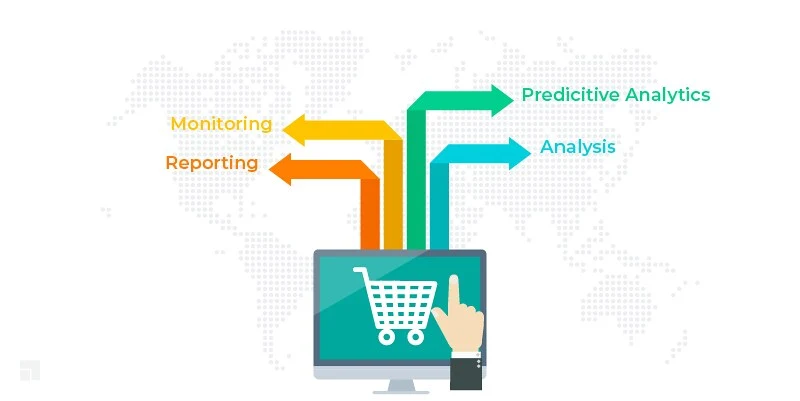In logistics, predictive analysis is simply the process of identifying and forecasting patterns, trends, and behaviors in both human and machine learning approaches, data, and algorithms.
It is accurate to state that logistics play a crucial role in how businesses run. It is essential to both customer satisfaction and operational effectiveness. But considering “out-of-the-box” options, such as logistics predictive analytics, can help you stand out in a market that is becoming more and more competitive.
Logistics professionals are already aware that managing operations in the usual ways might not be sufficient.
Predictive analytics can revolutionize how businesses approach logistics, which is where they come into play.
Despite the many benefits, there are application issues with predictive analytics deployment in logistics that businesses need to be aware of. Obtaining precise and trustworthy data is one of the biggest challenges.
There is a very good reason for this: the quality of the data used directly affects the quality of the predictions. After this, having trustworthy data is useless if the predictive insights cannot be adequately interpreted.
It is noteworthy to remark that predictive analyses in logistics can be quite beneficial, irrespective of the market. Predictive analysis can cut inventory expenses by as much as 30%, per a recent report.
We will discuss how to use these analyses in your company’s daily operations as well as the significance of predictive analyses in contemporary logistics, emphasizing its key advantages, uses, and real-world application.
Read also: Exploring the Impact of IoT in Logistics and Supply Chain
What is predictive analytics?
Predictive analysis is a branch of data analysis that makes predictions about patterns, behaviors, and habits based on past and present data using statistical methods and machine learning algorithms.
Finding patterns, trends, and connections that can be utilized to confidently anticipate future outcomes is hence its primary goal.
Numerous fields, such as sales forecasting, product demand, credit risk, medical diagnostics, equipment predictive maintenance, and logistics, might benefit from this.
How predictive analytics works in logistics?
Logistics operations can be optimized through the use of predictive analytics, which helps businesses anticipate future occurrences, make well-informed decisions, and increase the effectiveness of their supply chains.
Predictive analytics can be used in logistics, for instance, to estimate demand since it helps project future product demand based on previous sales data, seasonality, market trends, and other pertinent criteria. Additionally, they aid businesses in improving the planning of their distribution, inventory, and manufacturing.
Anomalies in logistics data, such as unapproved route diversions, delayed deliveries, and other occurrences that could endanger the supply chain, are also found using predictive analytics. This enables businesses to respond promptly to resolve problems.
When transportation businesses have to cope with a variety of routes and elements that significantly affect their operations, such as weather, traffic, and seasonality, that is another example of predictive analysis in action. Predictive analytics has the ability to foresee traffic and modify routes beforehand.
All of this predictability can also be utilized to forecast demand peaks for specific products during seasonal times, like Black Friday.
The business will be able to plan its supply chain more effectively in this way. Businesses can make bold decisions and steer clear of potential risks by seeing probable patterns.
The growth of the predictive analytics market in logistics
The field of predictive analytics has been steadily expanding in recent years due to a variety of variables. While economic viability was important, technology accessibility and businesses’ readiness for the future were also vital factors.
The COVID-19 epidemic has brought to light how crucial it is for businesses to have both flexibility and preparedness in order to handle unforeseen supply chain restrictions. A 2017 survey on the supply chain and logistics sector by MHI and Deloitte found that just 30% of supply chain managers employed software to facilitate data-driven decision-making. This ratio increased to 54% in 2022.
4 benefits of predictive analytics in logistics
When discussing the advantages of predictive analysis in logistics, it becomes evident why integrating it into your company’s daily operations as soon as you can is crucial.
We list the primary ones below.
1. Demand predictability
Predicting market demand leads to more effective inventory management.
What effects does this have, and how? You or your business can lessen the likelihood of product shortages and the requirement for unnecessary storage.
You will always have the appropriate supply to supply certain products, which reduces costs and increases customer satisfaction.
2. Delivery route optimization
Predictive analytics optimization of delivery routes has several significant advantages, including:
- reduced emissions;
- less wear and tear on automobiles;
- improved fuel economy;
- above all, the final point demonstrates a dedication to environmental sustainability.
3. Less likely to experience unplanned downtime
Unplanned disruptions are reduced when predictive maintenance of machinery and vehicles is supported by analytics in logistics. The cost of corrective maintenance is typically higher.
In addition, disrupting scheduled deliveries will have an adverse effect on client satisfaction and the reputation of your brand.
4. Optimization of Resources
The primary goal of predictive analysis is to anticipate demands beforehand. It is possible to employ the knowledge gained to better utilize the infrastructure and human resources that are at hand.
Practical applications of predictive analytics in logistics
We cover several instances in our discussion of the real-world applications of predictive analytics in logistics because they are extremely thorough. Among the most popular are the following:
In stock
Predictive analytics can be used in inventory management to forecast seasonal variations in demand. This enables businesses to modify their inventory levels in accordance with time periods.
On the routes
The predicted data collected during routing can be used to optimize resource allocation, shorten delivery times, and thereby improve customer satisfaction.
It’s also critical to emphasize that planning time and expenses have decreased in this regard.
In maintenance
Predictive maintenance is equally essential in logistics. And there’s a good reason for this: vehicles and equipment that are kept up properly can be used continuously and without interruption.
By using predictive analytics, damage indicators may be found and maintenance can be planned before problems arise.
According to data from the international business consulting firm McKinsey, predictive analysis and maintenance can both extend the useful life of equipment by 20 to 40% and reduce downtime by 30 to 50%.
How to apply predictive analysis in logistics step-by-step
A systematic methodology is initially required for the successful application of predictive analyses in logistics. We’ve created a detailed implementation guide to assist; have a look:
Step 1: Identify the data
Finding pertinent data for analysis is the first stage; this includes data on sales, inventories, traffic, weather, and more.
Logistics heavily depends on the accuracy of Big data since predictive insights are only as accurate as the evidence they are built on.
Step 2: Identification of patterns and trends
The learning algorithms are trained to recognize patterns and trends once you have completed all the data collection and cleaning.
To forecast future events, these algorithms are applied to fresh data. For the deployment process to be successful and seamless, cooperation between IT specialists, data scientists, and logistical teams is essential.
Warehouse Management Systems (WMS) are platforms that continuously track activities within a warehouse, turning that data into insights that help with scenario planning and optimal decision-making.
Step 3: Select algorithms and models
Once you have conducted an exploratory study on the data to gain a deeper understanding of its properties and find patterns and correlations that could be important for your predictions, it is time to select the predictive analysis algorithms that work best for your data and goals.
Step 4: Carry out the implementation
Deploy the models to a production environment after they have been constructed and verified so that they can produce predictions either continuously or in real time.
Step 5: Monitor
Keep an eye on the deployed models’ performance at all times. Models could become less accurate and data can vary over time. Models should be updated as necessary to maintain their accuracy.
Step 6: Finalize integration and conduct ongoing evaluations
Include the model-generated forecasts in your logistics procedures. This could entail planning delivery, adjusting stocks, and optimizing routes, among other things.
Subsequently, assess the outcomes after implementation and juxtapose them with the initial project objectives. Predictive analytics needs to offer observable advantages like cost savings, better customer support, or increased operational effectiveness.
Some more specific applications of predictive analytics in logistics
It is crucial to remember that the application of predictive analytics in logistics will differ based on the demands and goals of certain firms.
Predictive analytics can be used by an online e-commerce store to identify demand peaks during promotional times and modify its inventory and operations accordingly.
Based on weather and traffic projections, a transport company can optimize its routes to save operating costs and delivery times.
Risk management is another area where predictive analysis in logistics can be useful. Businesses can reduce the risks associated with delays and interruptions by planning ahead for such incidents.
These action plans may involve changing work teams, rerouting routes, or assigning additional resources.
Did you find the information provided useful? Visit the 3PL Links blog to read this and other explanations regarding fleet management and logistics-related concerns.




